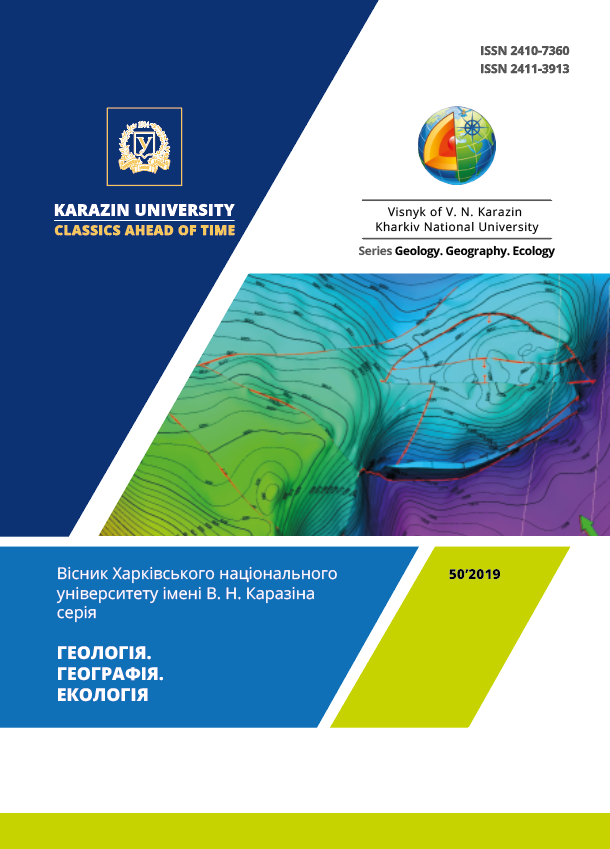Possibilities for improvement of environmental monitoring of precipitation in the city (a case of Lutsk)
Abstract
Formulation of the problem. The environmental parameters of precipitation in the city often differ from the background values and require the special observations program. The existing state monitoring system does not reflect the spatial differentiation of such parameters in urban areas, so it needs to be improved.
The purpose of the article: to find out the features of organization and implementation of rainfall environmental monitoring in urban areas, with the justification of the main parameters of observation and spatial placement of network points.
Methods. The main results are based on the authors' experience in own observations on the amount, acidity and mineralization of precipitation in several quarters of Lutsk during 2015-2018.
Results. Own observations and mapping of individual parameters of atmospheric precipitation in the city allowed to reveal the dependence of the indexes of acidity and mineralization on the amount of precipitation, air pollution, directions of air inflow, temperature, etc. The spatial differentiation of these indicators in the city is significant (the amplitude can reach up to 0.9 units of pH and 15-17 ppm of tds) and is related to the distribution of anthropogenic emissions and some microclimatic differences.
Therefore, by organization the system of ecological monitoring of precipitation in the city it is necessary to focus on the definition of such basic parameters: pH, total mineralization, amount of precipitation, and also concomitant: water and air temperature, direction of airflows, carbon dioxide concentration, duration of the previous rainless period, etc.
To select the representative locations for the control of precipitation in the city, it is necessary to analyze the following indicators: direction of prevailing winds, landscape and geomorphological features, the proximity of the most sources of anthropogenic contamination, building types etc. In this case, the minimum monitoring scheme should include such control points: the near and far outskirts (in relation to the arrival of prevailing air masses), the leeward sides of large industrial zones or transport interchanges, the largest green zone, area near the city water body, and several points (1-3) in residential areas.
Scientific novelty and practical significance. The main parameters and principles of the spatial organization of environmental monitoring of rainwater in the city are identified. The algorithm for creation such network has been tested in Lutsk and can be used for realization in other cities. Automation of similar measurements based on microcontrollers will to create quality non-state monitoring networks with the display of data in real time.
Downloads
References
Granat, L. (1972). On the relation between pH and the chemical composition in atmospheric precipitation. Tellus, 24(6), 550-560.
Morgan, J. J. (1982). Factors governing the pH, availability of H+, and oxidation capacity of rain. In Atmospheric chemistry Springer, Berlin, Heidelberg, 17-40.
Bogan, R. A., Ohde, S., Arakaki, T., Mori, I., & McLeod, C. W. (2009). Changes in rainwater pH associated with in-creasing atmospheric carbon dioxide after the industrial revolution. Water, air, and soil pollution, 196(1-4), 263-271.
Kakareka S., Belkovych O., Chuduk V. (2010). Izuchenye khymycheskoho sostava atmosfernyh osadkov i snezhnoho pokrova na urbanyzyrovannykh terrytoryjakh (na prymere h. Mynska) [The study of the chemical composition of precipitation and snow cover in urban areas (by example of Minsk city)]. Vestnyk BGU, Ser. 2., 1, 90-94.
Kozeruk B. (2014). Chemical composition of precipitation and snow cover in the Republic of Belarus. Available at : http://rad.org.by/articles/vozduh/ezhegodnik-sostoyaniya-atmosfernogo-vozduha-2017-god/himicheskiy-sostav-atmosfernyh-osadkov.html.
Budak I., Dyachuk V., Nikolayeva N. (2007). Map of precipitation acidity. – National atlas of Ukraine : e-version (DVD), Kyiv, SSPE "Kartographia".
Ohlyad stanu zabrudnennya navkolyshn'oho pryrodnoho seredovyshcha na terytoriyi Ukrayiny za danymy sposterezhen' hidrometeorolohichnykh orhanizatsiy u 2016 roci. [Review of the environmental pollution in Ukraine according to observations of hydrometeorological organizations in 2016]. Available at : http://www.cgo.kiev.ua/index.php?fn=u_zabrud&f=ukraine&p=1.
Sawicka-Kapusta, K., Zakrzewska, M., Gdula-Argasi, J., & Byd, G. (2005). Air pollution in the base stations of the environmental integrated monitoring system in Poland. WIT Transactions on Ecology and the Environment, 82, 465-475.
Kosovets-Skavronska O.O. (2010). Wet deposition of chemical substances in Ukraine and estimation of its contribu-tion to the formation of chemical composition of river water. – Manuscript. Kyiv National Taras Shenchenko Uni-versity, Kyiv, 20.
Khilchevsky V, Kurilo S. (2016). Сhemical composition of precipitation in Ukraine and its anthropogenic compo-nent. Hydrology, hydrochemistry and hydroecology: The scientific collection, 4(43), 63-74.
Lee, J. Y., Bak, G., & Han, M. (2012). Quality of roof-harvested rainwater–comparison of different roofing materi-als. Environmental Pollution, 162, 422-429.
Yaziz, M. I., Gunting, H., Sapari, N., & Ghazali, A. W. (1989). Variations in rainwater quality from roof catchments. Water research, 23(6), 761-765.
Tanner, P. A. (1999). Relationships between rainwater composition and synoptic weather systems deduced from measurement and analysis of Hong Kong daily rainwater data. Journal of Atmospheric Chemistry, 33(3), 219-240.
GIOŚ. (2017). Stan środowiska w Polsce. Sygnały 2016. Warszawa. 86.
Fedoniuk M. (2013). Do pytannya udoskonalennya systemy derzhavnoho ekolohichnoho monitorynhu stanu at-mosfernoho povitrya [On the issue of improving the state system of air environmental monitoring] Derzhavne upravlinnya: udoskonalennya ta rozvytok, 2. Available at : nbuv.gov.ua/UJRN/Duur_2013_2_6.
Dzyublyuk T. Kovalchuk I. (ed.), Koltun O. (2005). Geoekologichny monitoryng Khmelnytskoyi urbosystemy [Geo-ecological monitoryng of Khmelnytsk urbosystem]. Lviv, 108.
Laquer, F. C. (1990). An intercomparison of continuous flow, and automatically segmenting rainwater collection methods for determining precipitation conductivity and pH. Atmospheric Environment. Part A. General Topics, 24(9), 2299-2306.
Fedoniuk V., Ivantsiv V, Fedoniuk M., Ivantsiv O. (2016). Environmental state mapping of air basin town Lutsk based on lichen indication. Chasopys kartografiyi [Magazine of cartography], № 16, 259-271. Available at: map-times.inf.ua/CH_16/24.pdf.
Deletic, A. (1998). The first flush load of urban surface runoff. Water research, 32(8), 2462-2470.
Geretsun G., Masikevich Yu. (2013). An analysis of the risk-forming factors of atmospheric precipitations in Сhernivtsi. Ekologichna bezpeka [Ecological safety], 2(16), 40-43.





